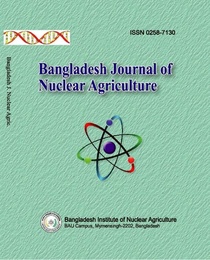GAMMA RAY INDUCED RADIOSENSITIVITY OF BLACK CUMIN GENOTYPE (Short Communication)
Abstract
Mutagenesis using ionizing radiation has been widely used for the genetic variability with novel characteristics. To know the optimum dose in black cumin an experiment was carried out at Bangladesh Institute of Nuclear Agriculture, HQs farm, Mymensingh. Collected three germplasm (BC10861, BC10863 and BC10864) of black cumin seeds were irradiated with different doses of gamma radiation as 50 Gy, 100 Gy, 150 Gy, 200 Gy, 250 Gy and 300 Gy to determine the LD50 for development of desirable mutants. Maximum seed germination (94.5-97.1%) was found from the lowest dose (50 Gy) of gamma radiation, while the minimum germination (18.2-22.0%) was obtained from the highest dose (300 Gy) among the three germplasm BC10861, BC10863 and BC10864. The seedlings survivability was 45-49% at 150 Gy. After one month, in the later growth stage none of the seedlings survived at the dose of 250 Gy and 300 Gy. At lower dose of 50 Gy maximum numbers of leaves (6.12-7), number of roots per plant (7.13-8.05), root length (5.34-7.1 cm), shoots length (5.3-7.1 cm) and fresh weight per plant (0.25-0.29 g) were observed among the germplasm. The seed germination and seedlings survival decreased with the radiation dose increased. The seedling growth parameters like number of leaves, root length, shoot length and fresh weight per plant reduced around 50% at 150 Gy dose of gamma radiation. Among the six doses of irradiation the LD50 was close to 150 Gy which caused around 55-51% death of seedlings, 45-49% seedlings survival and around 50% reduction in plant growth. Hence, it is concluded that 150 Gy may be the optimum dose for creating useful mutation induction in black cumin.
References
Ahloowalia, B.S., Maluszynski, M. and Nichterlein, K. 2004. Global impact of mutation-derived varieties. Euphytica135: 187-204.
Ambavane, A.R., Sawardekar, S.V., Sawantdesai, S.A. and Gokhale, N.B. 2015. Studies on mutagenic effectiveness and efficiency of gamma rays and its effect on quantitative traits in finger millet (Eleusine coracana L. Gaertn). Journal of Radiation Research and Applied Sciences 8: 120-125.
Bashir, S., Wani, A.A. and Nawchoo, I.A. 2013. Mutagenic sensitivity of gamma rays, EMS and sodium azide in Trigonella foenum-graecum L. Science ResearchReporter 3(1): 20-26.
Chahal, G.S. and Gosal, S.S. 2002. Principles and procedures of Plant Breeding. Oxford: Alpha Science International Ltd. pp. 399-412.
Gomez, K.A. and Gomez, A.A. 1984. Statistical procedures for agricultural research. John Wiley and Sons, USA.
Khan, S. and Goyal, S. 2009. Improvement of mungbean varieties through induced mutations. African Journal of Plant Science 3: 174-180.
Kovacs, E. and Keresztes, A. 2002. Effect of gamma and UV-B/C radiation on plant cells. Micron 33: 199- 210.
Lal, G.M., Toms, B. and Lal, S.S. 2009. Mutagenic sensitivity in early generation in black gram. Asian Journal of Agricultural Science 1: 9-11.
Malhotra SK 2004. In: Handbook of Herbs and Spices, Woodhead Publishing Series in Food Science, Technology and Nutrition. 2: 206-214.
Micco, V.D., Arena, C., Dand, P. and Durante, M. 2011. Effects of sparsely and densely ionizing radiation on plants. Radiation and Environmental Biophysics 50: 1-19.
Micke, A. and Donini, B. 1993. Induced mutations. In Hayward, M.D., Bosemark, N.O. and Romagosa, I. (edited) Plant breeding principles and prospects. Chapman and Hall, London. pp. 52-62.
Mutant Variety Database, IAEA. 2021. https:// mvd.iaea.org.
Preussa, S.B. and Britta, A.B. 2003. DNA-damage induced cell cycles check point in Arabidopsis. Genetics 164: 323-334.
Sakamoto, W. 2006. Protein degradation machineries in plastids. Annual Review of Plant Biology, 57, 599-621
Sarada, C., Jyothi, K.U.V., Rao, S. and Reddy, P.V. 2015. Mutagenic sensitivity of gamma rays, EMS and their combinations on germination and seedling vigour in coriander (Coriandrum sativum L). International Journal of Advances in Pharmacy, Biology and Chemistry 4(2): 430-438.
Sastry, E.V.D. and Anandaraj, M. 2013. Cumin, Fennel and Fenugreek”. Soils, plant growth and crop production. Encyclopedia of Life Support Systems (EOLSS). Pp. 1-10.
Verma, A.K., Sharma, S., Kakani, R.K., Meena, R.D. and Choudhary, S. 2017. Gamma radiation effects seed germination, plant growth and yield attributing characters of fennel (Foeniculum vulgare Mill.). International Journal of Current Microbiology andApplied 6: 2448-2458.
Yadav, S.K. and Ramkrishna, R. 2013. Effectiveness and efficiency of physical and chemical mutagens on cumin (Cuminum cyminum L.). Vegetos 26: 44-49.
-
Download



